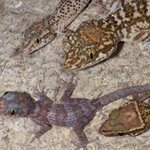Evolution

Two papers published this week have proposed explanations regarding the evolution of social monogamy among mammals and especially primates. Of three competing hypothesis, one proposes that a driving force in establishing social monogamy was the protection of offspring by preventing male infanticide, while the other proposes that social monogamy is the result of female intolerance towards each other and a low population density that simply prevents males from adequately "guarding" females from other males (1).
Both papers agree that the idea of paternal care is a consequence of social…

Music is an
ancient and important expression of human creativity, and is an intrinsic part
of culture. It can be argued that creative expression is what makes our species
unique among those on earth, and hence, musical appreciation is something which
is well worth studying.
What makes a series of sounds in a particular sequence more pleasing to the
human ear (and brain which interprets it) than another series of sounds, in a
different order? As any composer will know, only some tunes and melodies really
‘work’, but when they do, they can become so memorable and iconic that a piece
can…

A study of mortality and fertility patterns using seven species of wild primates (apes, monkeys etc.) compared with similar data from hunter-gatherer humans found that menopause sets humans apart from other primates.
It isn't that non-human primates are immune from the fading female fertility that comes with age, rather that human females are unique in living well beyond their childbearing years.
The study compared mortality and fertility data for seven species of wild primates based on long-term observations of 700 adult females, including capuchins in Costa Rica, muriqui monkeys in…
Most mammals aren't monogamous, nor are most anything except birds, where it happens in about 90% of cases.
It's actually quite rare in mammals (5%), so why did it evolve? Was it to be better parents together, to protect offspring from being killed by other males or instead to protect women from competitors? Well, it depends on who you ask.
Being a solitary individual who can't run all over the place protecting females from other males wins the prize, according to Cambridge zoologists Lukas and Clutton-Brock, who looked at 2,000 species of mammals and determined that when breeding…

Male guppies must not be very sexy, because they have evolved an extreme way to hold on to a female that interests them, even if that affection is unrequited: claws on their genitals to make it more difficult for unreceptive females to get away during mating.
Genitalia differ greatly in animal groups, even among similar species – so much so that even closely related species may have very different genitalia. The reasons for these differences are unclear but sexual conflict between males and females may be a source. Sexual conflict occurs when the fitness interests of males and females…

Adineta vaga, the delloid rotifer, abandoned sex yet still produced more than 460 species over evolutionary time.
Rather than the standard way of using sexual reproduction to weed out harmful mutations to its DNA, this tiny aquatic animal appears to have adopted other strategies to maintain lineages over millennia that aren't burdened by genetic damage or killed off altogether.
Neither males nor meiosis (cell division to produce sperm or eggs) have ever been observed in a bdelloid rotifer. Instead, the unfertilized eggs just divide to produce offspring. This reproductive strategy, which for…

When is a tuna more like a seahorse than a marlin?
Science!
The first comprehensive phylogeny of the "spiny-rayed fish," a group that includes about a third of all living vertebrate species, has been published in the Proceedings of the National Academy of Sciences.
The spiny-rayed fish are an incredibly diverse group, including tuna and billfish, tiny gobies and seahorses, and oddities such as pufferfish and anglerfish. The fish occupy every aquatic environment from coral reefs and open oceans to lakes and ponds and the group includes all the major commercially fished species.
The…

An unknown physiologic mechanism of evolutionary biology has been the ability of mammals to manipulate the sex ratios of their offspring as part of a highly adaptive evolutionary strategy. A new paper analyzing 90 years of breeding records from the San Diego Zoo says that mammalian species can "choose" the sex of their offspring in order to beat the odds and produce extra grandchildren.
The scientists assembled three-generation pedigrees of more than 2,300 animals and found that grandmothers and grandfathers were able to strategically choose to give birth to sons, if those sons would be high-…

Madagascar represents only one percent of the earth's area but is home to about three percent of all animal and plant species on the planet - it has long been known as a hotspot of biodiversity.
New research in Proceedings of the Royal Society B suggests the island's heyday of species development may be all but over.
The study analyzed the evolutionary records of seven groups of reptiles and amphibians that are found across the island, including tiny leaf chameleons (which can rest comfortably on a matchstick), colorful and charismatic day geckos (of television insurance ad fame), and…

Sir Archibald
Henry Bodkin, KCB (1862–1957) was our British Director of Public
Prosecutions from 1920 to 1930. He particularly took a stand against the
publication of what he saw as ‘obscene’ literature.
In the 1920s he tried
to ban Ulysses by James Joyce and even threatened in 1922 to prosecute
the academic F. R. Leavis if he mentioned it in his lectures at Cambridge
University since it contained “a great deal of unmitigated filth and
obscenity”. On December 29, 1922 he banned the book, saying “As might be
supposed I have not had the time, nor may I add the inclination to read…